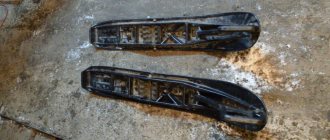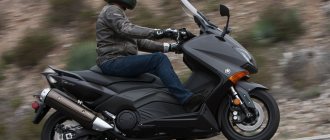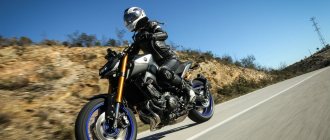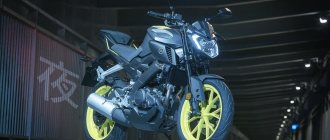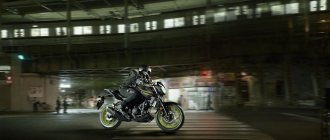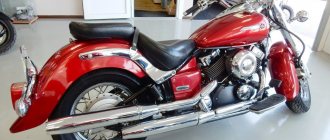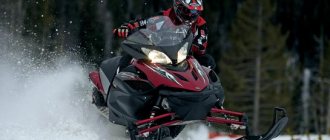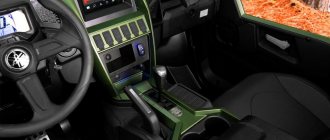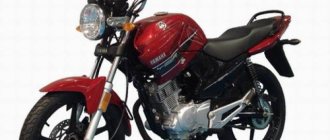The main differences between the Yamaha TDM900 and the Yamaha TDM850:
Deltabox aluminum frame instead of steel - 29% lighter;
New modified and lightweight engine of increased volume;
Injection power system instead of carburetors;
6-speed gearbox instead of 5-speed;
New 4-piston front brakes from the sporty Yamaha R1;
New 1-piston rear caliper (instead of 2-piston);
The appearance of modifications with ABS (distinguished by a black frame and the name - Yamaha TDM900A);
New lightweight 3-spoke wheels, increased wheel width (120 and 160 mm respectively);
Reduced curb weight (from 232 kg to 221 kg).
However, the main advantage of the Yamaha TDM 900 is the absence of the “sores” of the previous TDM850 - all the problems of the older versions of the motorcycle have been eliminated. This effect was achieved both by using more advanced mechanisms (the problematic rear caliper was replaced with a new, more advanced one) and modern solutions (the problem with carburetors was solved by introducing an injector), and by refining existing components (lightening the engine, using other materials and elements).
Short description
Yamaha TDM 900 was released in 2002. This version began to be produced immediately after the TDM 850. It is believed that “TDM 900” is a new generation of the 850 version. But similarity in design does not mean anything, because the TDM 900 has undergone many changes:
- the steel frame was replaced with aluminum, which became 20 percent lighter, adding handling and driving dynamics;
- engine volume increased and weight decreased;
- the power system is now controlled by an injector rather than a carburetor;
- six-speed gearbox (TDM 850 has a five-speed gearbox);
- new brakes borrowed from the R1;
- new modification with the prefix “A”;
- wheel weight has been reduced;
- curb weight was reduced by 11 kilograms.
But this is not the most important thing. In the new version, all the problem areas of the TDM 850 were removed and corrected, namely: the rear caliper was replaced with a higher quality one, the carburetor was replaced with an injector, stronger and lighter materials were used, both in the frame and in the engine.
There are two versions of this motorcycle: the standard version “TDM 900” and the version “TDM 900A” (externally it differs from the standard version only in the color of the frame).
Main modifications of Yamaha TDM 900:
Yamaha TDM900 is the standard version of the motorcycle.
Yamaha TDM900A - version with ABS. It has been available on the market since 2004. Visually distinguished by a black frame. In a number of European countries, only these versions were available (due to legislation requiring all new motorcycles to be equipped with an ABS system).
The Yamaha TDM900 was based on an in-line 2-cylinder liquid-cooled engine with a volume of about 900 cc, producing 86 hp. power and almost 89 Nm of torque. The engine is medium-speed, with maximum performance at 6000-7500 rpm. Like previous modifications of the TDM850, the new TDM900 engine was also equipped with a 270° crankshaft, due to which the mixture ignited asymmetrically (with a delay of half a stroke), which made the engine operate similar to a V-shaped cylinder arrangement.
Other features of the Yamaha TDM900 include an aluminum frame, adjustable suspension, powerful brakes (taken from the sports Yamaha R1), a 20-liter fuel tank and 221 kg of curb weight (224 kg for the version with ABS).
2010 was the last year of production of the Yamaha TDM900, but official sales continued until 2012 inclusive. Unfortunately, the model series did not receive a direct continuation. Only in 2015, a modification of the MT-09 model appeared - the Yamaha MT-09 Tracer, which can be considered as a kind of continuation of the TDM900, although these are completely different motorcycles.
Peculiarities
The basis of the new version of the Yamaha TDM 900 is a 2-cylinder engine with a volume of 900 cm³ and a power of 87 horsepower. The crankshaft of the new engine has not changed - still the same 270 degrees. Thanks to the crankshaft, the fuel ignites asymmetrically, thereby making this engine similar to a V-shaped one.
Another important feature is the aluminum frame, which made the motorcycle lighter by 11 kilograms.
Production of the Yamaha TDM 900 officially ended in 2012. This series was not released as new models. But in 2015 they released a motorcycle similar to it - the Yamaha MT-09 Tracer, although this is a completely different motorcycle.
The features of the Yamaha TDM 900, judging by the reviews, are as follows:
- excellent motor with large volume;
- comfortable fit, one of the best in the Yamaha lineup;
- good technical characteristics;
- design.
The frame and suspension are made of aluminum. The suspension can be adjusted depending on the driving pace and load. On older models, according to the owners, the motorcycle lost its stability at speeds exceeding the permitted speed. Now there is no such problem thanks to the improved suspension.
Wind protection on the Yamaha TDM 900 is excellent. Thanks to the streamlined body and low seating position, the driver does not feel the wind at all. A headwind is not a problem, but side winds are a problem.
Each element on the instrument panel is clearly visible and easy to read. Despite the fact that this motorcycle belongs to the road class, it has a large display that indicates engine speed, speed, fuel and oil levels, as well as other indications.
The brakes modified after TDM 850 now work flawlessly. The brakes on the front wheel are the same as on the Yamaha P1. Nothing special for a weight over 400 kilograms. This won't hurt at all, and in some cases it will even help. Since all the mass is located on the front axle, powerful brakes on the rear axle will not be as effective as on the front axle.
Brief history of the model
2002 - start of production of Yamaha TDM 900. Factory designation - RN08. An example frame number (Japan) is JYARN08XXXXXXXXXX. Model: Yamaha TDM900 (Japan, Europe, Oceania). Factory designation: 5PS1, 5PS2.
2003 - no significant changes. Model: Yamaha TDM900 (Japan, Europe, Oceania). Factory designation: 5PS4, 5PS5.
2004 - factory designation - RN11. An example frame number (Japan) is JYARN11XXXXXXXXXX. The model receives changes to the engine control unit and front fork (all adjustments). Versions with ABS appear (in some European countries they are standard equipment), the motorcycle receives an immobilizer. Versions with ABS are called Yamaha TDM900A. The visual difference is the frame is black. Model: Yamaha TDM900, Yamaha TDM900A (ABS) (Japan, Europe, Oceania). Factory designation: 5PS6, 5PS7.
2005 - no significant changes. Model: Yamaha TDM900, Yamaha TDM900A (ABS) (Japan, Europe, Oceania). Factory designation: 2B01, 5PS8, 5PS9.
2006 - no significant changes. Model: Yamaha TDM900, Yamaha TDM900A (ABS) (Japan, Europe, Oceania). Factory designation: 2B02, 5PSA.
2007 - factory designation - RN18. An example frame number (Japan) is JYARN18XXXXXXXXXX. The model receives a new catalyst and meets Euro-3 emission standards. Maximum power is reduced to 85.02 hp. Model: Yamaha TDM900, Yamaha TDM900A (ABS) (Japan, Europe, Oceania). Factory designation: 2B03, 5PSC.
2008 - no significant changes. Model: Yamaha TDM900, Yamaha TDM900A (ABS) (Japan, Europe, Oceania). Factory designation: 2B04, 2B05, 5PSE, 5PSF, 5PSG.
2009 - no significant changes. Model no longer available in Oceania. Model: Yamaha TDM900, Yamaha TDM900A (ABS) (Japan, Europe). Factory designation: 2B07, 5PSH.
2010 - Yamaha TDM 900 model discontinued. Official sales end in 2012. Model: Yamaha TDM900, Yamaha TDM900A (ABS) (Japan, Europe). Factory designation: 2B08, 5PSK.
Lyrical absence or agony of choice
After trying Goose, I was clearly struck by the fact that nothing suited me and I began intensively scouring the Internet for alternative options for a good motorcycle for every day.
At some point, a crazy thought drove me towards the nakeds, after which, with the effort of the remnants of rational thinking, the gray mass between the ears was inclined towards the CB1000R, but, as happens in this life, chance put everything in its place. After another day at work, I drove along an unfamiliar road, and then in the evening I replayed the same route in my head on the “cool naked” CB1000R and realized that one thing doesn’t fit with the other. This kind of waste makes you “light up for no reason” and confidently “tear everyone one by one and together into rags,” but in fact you want to calmly, without proving anything to anyone and without throwing yourself under the wheels of another teenager in a retuned Golf, get to your destination with a sufficient reserve of power and (which is important) stroke (CB1000R for a long time without nipples... can’t withstand gas pumps). In general, we pull ourselves together, grow up and think about more “serious” spendthrifts. And then the thought smoothly flowed to where we actually started... namely, the road workers.
Due to Yamaha’s “commitment to the brand,” until now, the solid TDM that has remained unchanged for years has been chosen as a candidate. The rest is either too off-road (and you need to look for this here, and in 10 years I’ve only gotten out of the asphalt once (!)) or sporty (spare your arms and back) or the price (I’m not yet ready to pay [much] more for the bike than for a car). As a logical continuation of the 4-cylinder road family, the Honda CBF1000 was chosen, with a semi-fairing, locomotive (according to reviews) thrust throughout the entire range (“the cat” until you spin it won’t do any good, but driving at 8 thousand rpm in the city... oops, “countryside” , somehow awkward).
Characteristics:
| Model | Yamaha TDM900 |
| Motorcycle type | road |
| Year of issue | 2002-2010 |
| Frame | aluminum Deltabox |
| engine's type | 2-cylinder, 4-stroke, in-line |
| Working volume | 897 cc cm. |
| Bore/Stroke | 92.0 x 67.5 mm |
| Compression ratio | 10.4:1 |
| Cooling | liquid |
| Number of valves per cylinder | DOHC, 5 valves per cylinder |
| Fuel supply system | injector, 2x 38EIS (Mikuni) |
| Ignition type | digital TCI |
| Maximum power | 86.2 hp (63.4 kW) at 7500 rpm (85 hp - since 2007) |
| Maximum torque | 89.0 Nm (9.0 kg-m) at 6000 rpm |
| Transmission | 6-speed |
| type of drive | chain |
| Front tire size | 120/70ZR-18M/C (59W) |
| Rear tire size | 160/60ZR-17M/C (69W) |
| Front brakes | 2 discs, 298 mm, 4-piston calipers (TDM900A - with ABS) |
| Rear brakes | 1 disc, 245 mm, 1-piston caliper (TDM900A - with ABS) |
| Front suspension | 43 mm telescopic fork (adjustable), travel - 150 mm |
| Rear suspension | pendulum with monoshock absorber (adjustable preload and rebound), stroke - 133 mm |
| Motorcycle length | 2180 mm |
| Motorcycle width | 800 mm |
| Motorcycle height | 1290 mm |
| Wheelbase | 1485 mm |
| Seat height | 825 mm |
| Acceleration to 100 km/h | 3.9 sec |
| Maximum speed | 210 km/h |
| Gas tank capacity | 20.0 l (including reserve - 3.5 l) |
| Motorcycle weight (dry) | 190 kg - TDM900 193 kg - TDM900A (with ABS) |
| Motorcycle weight (curb) | 221 kg - TDM900 224 kg - TDM900A (with ABS) |
Reviews
Owner reviews of the Yamaha TDM 900 are very positive, considering the fact that the motorcycle has gone through many tests, becoming an almost flawless unit for many motorcycle enthusiasts. I loved it primarily for its versatility. And all the owners talk about it.
Reviews about "Yamaha TDM 900". can be divided into positive and those containing criticism. Here are the advantages:
- lightweight, durable frame that adds handling and dynamics;
- design, namely the elements that make it both a road bike and an off-road bike;
- an ideal motorcycle for driving around Russia;
- low fuel consumption;
- comfort;
- comfortable fit;
- inexpensive motorcycle maintenance;
- nimble gearbox;
- reliability;
- permeability;
- visibility.
Minuses:
- lack of a central footrest;
- standard windshield;
- A typical front fork for a motorcycle of this class.
Try
So it’s Groundhog Day... in the “opstapdag” sense. As soon as the family let me go, I rushed to the dealer, not forgetting to take my license with me. Instead of the expected crowd, there were five heels of bored “potential clients” lazily looking around at everything. I looked around again and licked my lips at the cute Yamaha FZ8, but after sitting down and touching the plastic, I left it standing without regret. Landing with an inclination forward, i.e. in half an hour, hello numb hands and this plastic... in general, it’s only cool in appearance, but feeling the bending fairing under your hand is somehow unpleasant. OK. Let's start pestering the sellers. — Are you trying here? - Like we have... - So. - What are we focusing on? — Road workers, sir...
Yamaha TDM 900
The first to offer to saddle TDM. There was no demo model, they kicked me out of what was in the room from a used one, but at least it’s the 900th, not the 850th :). The specimen, as it later turned out, was quite well-worn. 2002, 64 thousand km on the odometer and with... three panniers. The first thought is that the main thing is not to rush between cars out of habit, otherwise it will take a long time to file an insurance claim. By the way, to close the topic of panniers, I don’t know who rode it, but getting on the motorcycle turned out to be a non-trivial task. My “stretch” was barely enough, while the seller with clearly more experience had no less of a problem. Okay, having solved the problem of an empty gas tank in 5 minutes, they gave me a “horse for walking.” I’m sitting high, far away... well, let’s go. The first couple of meters showed that the “old man” had enough torque at the bottom, I successfully dangled in the seat from the jerks of the clutch being released at the wrong time, but got used to it the third time.
Of the good. Despite the respectable mileage, I would say that the bike (or rather, the engine) turned out to be more pleasant than the V-Strom DL-650 and F700GS. I don’t know what this is connected with, but it is still more powerful and clearly has enough torque. Still, there was no “undermining” and the rev arrow “lives” in almost the “automotive zone” (obviously limited “room for imagination”), but there were no particular complaints about traction. There is pickup, but not under the ringing of an in-line four, but under the confident rumble of a two-wheeler (in this Yamaha almost won me over - this is not the rattling of a BMW or Suzuki, but a completely sedate bass). Still, there is a charm in a two-room apartment, although I only felt it on TDM (by the way, people call it “Tygydym” :)).
To put it mildly, I was not happy with the cornering. Despite the comfortable seating position (unlike the F700GS) and the adequate width of the steering wheel (unlike the V-Strom), I specifically had to steer into the turn. Before this, in my driving practice, the steering wheel was used only when turning (and even, rather, turning) at a walking speed, but here, on a completely adequate rotunda, which I pass 2 times a day, I began to “twist” the steering wheel. “Strange”... When I returned I complained to the seller, he drove it around and said that it was really abnormal, like the pressure in the tires combined with wear and all that. Although at the same time I scratched my turnip - yesterday, supposedly, people rode around for half a day and said nothing. I didn’t specify, but I suspect that the purchase was not discussed...
To top off the topic of steering, despite the seemingly comfortable steering wheel, towards the end I began to feel a slight ache in my palms. Either I had to steer so actively, or the handles were still slightly turned “inward,” but I wanted to “straighten” the steering wheel slightly. Having tried the new one again, I still don’t understand whether it is so, or just a glitch.
Another positive thing is a comfortable seating position, a pleasant solid “sofa”, in some ways akin to a “cat” gear, the gears are switched quite sanely, it’s not for nothing that people easily spend several thousand on them per trip.
In general, “to complete the experience,” I made an additional detour and returned to the dealer. There I talked a little with the seller - according to them, Yamaha dropped the price this year (I didn’t keep track, I don’t know), which made it even more attractive, but it obviously didn’t blow me away :-\.
The bottom line is that it’s quite possible to live with TDM, but for me it would clearly be a compromise, especially when compared with...
Honda CBF1000
In fact, I didn’t immediately expect that they would let me ride. They gave me one, and that was good :), but, apparently, there weren’t many people there, I had a blaze of enthusiasm in my eyes, and they finally rolled out the newest one they had (they didn’t have a completely new one), 2010, with 20 thousand km on the odometer. In fact, the latest model, with “variable geometry” of the windshield, one exhaust and new optics.
The beginning was fun - it... didn’t start. But the thing is, the dead battery was solved in 15 minutes, however, we had to unscrew two bolts to remove the driver’s seat, under which there was, in fact, the battery. Slightly unusual, especially considering that in the “cat” everything is filmed at once (and on TDM too). Well, that's not the point. Just a quick note - when traveling you need to have the appropriate key with you, otherwise you won’t even be able to recharge.
They started it. Hmm... buzzing. It doesn’t puff, doesn’t rumble, but just “buzzes.” “Funny”... But the main thing is how does it drive? The fit turned out to be, I’m not ashamed, perfect (about 10 years ago I had the same thought from the “cat” - “they cut it for me”). I sat down and everything was in place. You don’t need to reach for anything, your arms just lay down, your legs become. Hm. We stick the gear in (no ringing of a “gremlin blacksmith in a Yamaha cap”, quietly and measuredly), lightly throttle and... nirvana has arrived. The closest thing I could come up with was an electric motor. From the very bottom, the first couple of thousand are just trolleybus traction, no twitching, coughing or shaking. It even became fun. Well, okay, the main thing is that it’s not always like this. And then you can fall asleep! But everything is fine. It’s just great, because if you unscrew and “send” the needle in the direction of 10 thousand, then the combat history of this engine makes itself felt. Without stupidly lifting the front wheel, it, as befits a decent locomotive, “rushes” in the given direction without a single hint of embarrassment or lethargy (but also without unexpected “pickups”, which at certain moments can be very inappropriate). At the same time, a very decent aria is emitted through the exhaust pipe, which is usually located on the starboard side. What else do you want? For the first time in the last 8 years I again wanted to have fun screaming in a helmet along with the engine :). And I thought this kind of excitement had already passed...
The very first turns put a finishing touch on the verdict - this is my spendthrift! I have never ridden on these paths so fast (and I drive there to work every day). I completed the entire “circle” (at least according to my impression) two times faster than on TDM. At the same time, without really disclosing the speedometer numbers, I can say that I have not yet decided to “fly” along these “convolutions”. The presence of traction throughout the entire range opens up much more room for maneuver in those places where the “cat” peacefully “purred” behind a line of cars. By the way, on the way home in the “cat” I decided to repeat the race, it turned out much louder (more resourceful) and with much less impact from the brakes... The latter made me think hard about the wisdom of this experiment.
By the way, about the brakes - I have long been attracted by the idea of a “joint” Honda brake, and after trying it I was not disappointed. For the last 5 years in a “cat” I have completely stopped using the rear brake after another “skid” with the rear wheel blocked from sudden braking on a wet highway (if there is a passenger, it is a completely different story - the weight distribution and requirements for the brakes are different). Somehow this did not add confidence to me and I simply developed the habit of placing my right foot away from the rear brake foot (for those who don’t know, the front brake lever is under the right hand, the rear brake foot is under the right foot, almost all motorcycles have separate brake levers, but Honda has its own system for activating both when you press one of the brakes). As a result, when changing the front pads, the old ones remained in place, since there was practically no wear... Some might say that it's gone. I would agree, but not in this case, especially if such “vulgarity” will save you in a suddenly critical situation.
With Honda, oddly enough (considering the city’s predisposition to careful, measured driving), I even managed to try ABS when the “handsome guy” in front of me suddenly decided to turn right, forgetting to inform other road users about it. A slight short squeak of rubber and oh-so-confident braking only added pluses to Honda’s piggy bank. Whatever, the brakes must be at their best (and not make you nod or even throw the rider out of the seat).
From “so-so” it doesn’t give the impression of a “liter”. Externally - just 600, and even with one (from 600 and inherited, by the way) burning headlight. Squalor. This is the first modification to make - turn both headlights on for low beam.
One of the really nitpicking things is the short arms ;). Probably, after the headlights, the second modification is to install elongated tips, which somehow look and feel more comfortable. Well, for completeness’ sake, the digital speedometer is pure show-off. As for me, the analog needle (of a reasonable length :)) is great to read on the go. Or maybe I’m just drawn to the classics :). But even analog instruments can still be ruined by the same show off - the numbers on the CBF's tachometer just need to be learned by heart - the thin non-standard font is hard to read on the go. Why ask... Otherwise, the tidy is adequate - not a “garland” of flashlights like on the V-Strom, but a completely visible row of readable light bulbs (and without a useless gear indicator except neutral! :)).
Well, the last thing... Probably just inspired by the reviews - can such a spendthrift get boring? They say yes, but a much more interesting question is - can you ride it for fun and a lot? But here it’s a definite “yes”!
